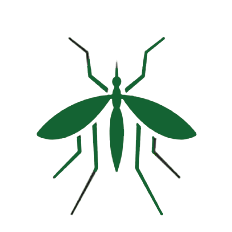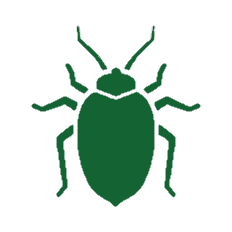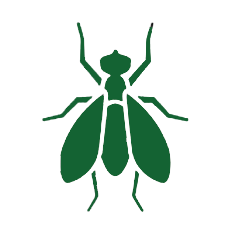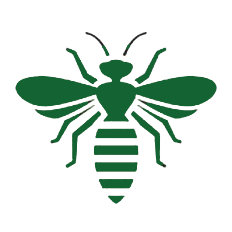OUR SERVICES
OTHER SERVICES
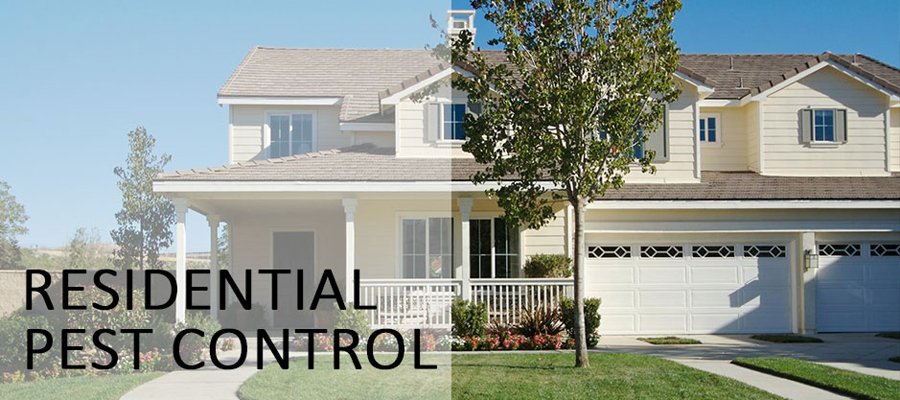
Pest problems in home is not a pleasant nice feeling. Pest infestation can cause even the cleanest house. With the help of our professional experienced Better Care pest control team, keep unwanted pests away from your home.
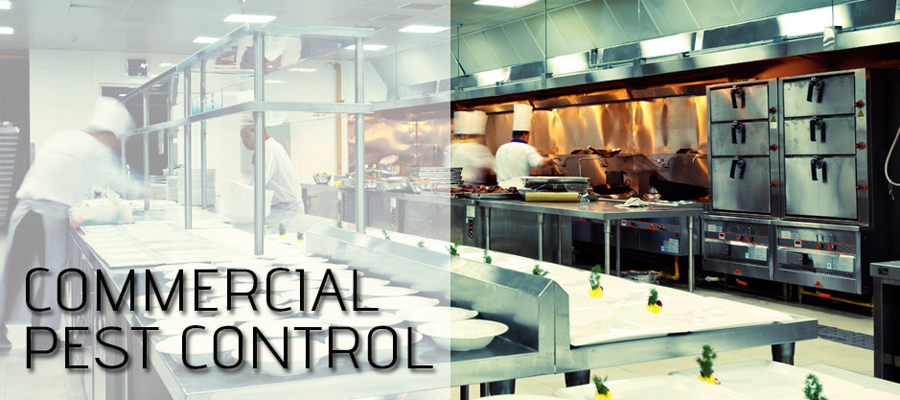
Pest problems in your business or organization becomes a major problem. It can create a negative effect on you reputation, damage goods and creates public health issues. Better Care Pest Control is your right choice for environmentally safe solution.
WHY CHOOSE US?
Better Care is a locally established pest control company that provides pest control services to residential, commercial and industrial sectors. We are specializing in mosquito, bed bugs, cockroaches, flies, rodents, ants, termites and other pest control. Our mission has always been to provide you with timely service and effective solutions from professionals you can trust.
- Free Survey
- Affordable price
- 24/7 Service Available
- Fast & Effective Solution
- Fully qualified technician
- Environmentally friendly techniques
- 100% Satisfaction Guarantee
When you find pests in your home, we know that you want them gone as quick as possible, then Bettercare will offer you full day service.
Bettercare offers timely, pro-active prevention with minimum impact on your family, home life and budget. That makes us one of the best affordable services.
Every day, more families choose us as their pest control company because of what they get.
We treat your home as if it was our own. We keep our appointment and deliver our best every time we visit your sweet home.
WANT TO KNOW MORE ABOUT US?

If you have pest problems, contact us today for a free, no obligation estimate. One of our friendly, experienced technicians will come out and assess your situation.
RESEARCH A PEST
Learn how to identify common pests; understand their biology, diet, and habits and find out what you can do to control them.
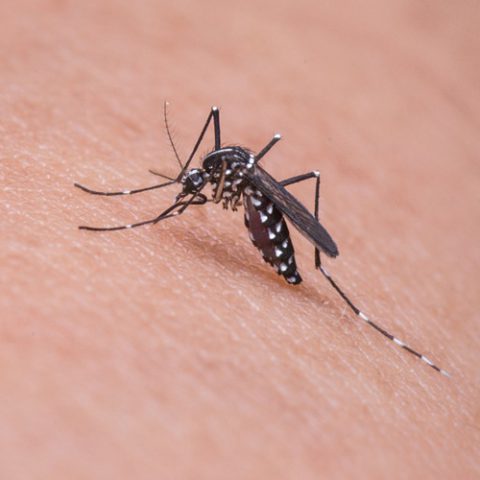

Mosquitoes
MOSQUITOES
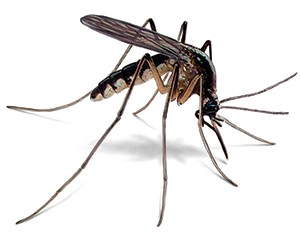
Family: Culicidae
Appearance:
Mosquitoes belong to the same group as the true flies, Diptera. As such, they have a single pair of wings. They typically have long, thin legs and a head featuring a prominent proboscis. Mosquito bodies and wings most often are covered in tiny scales. Adult sizes may range from 3 to 9 mm.
Common types of mosquitoes:
- Culex Mosquitoes
- Aedes Mosquitoes
- Anopheles Mosquitoes
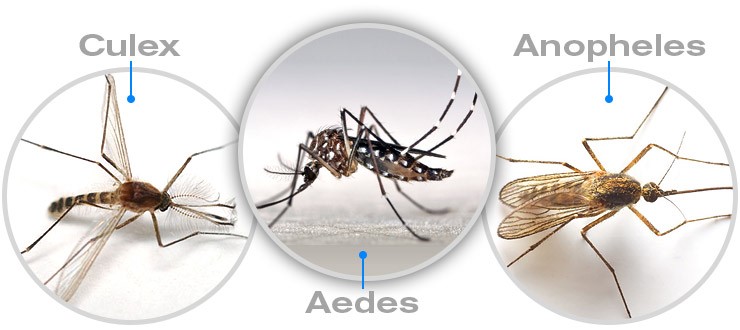
Culex Mosquitoes
Typically bite at night both indoors and outdoors; they prefer avian hosts, but will bite humans.
Lay eggs in rafts on the water surface of polluted freshwater sites and artificial containers.
Transmit diseases : Elephantiasis, Encephalitis
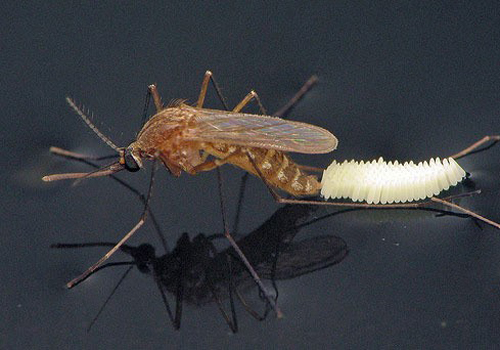
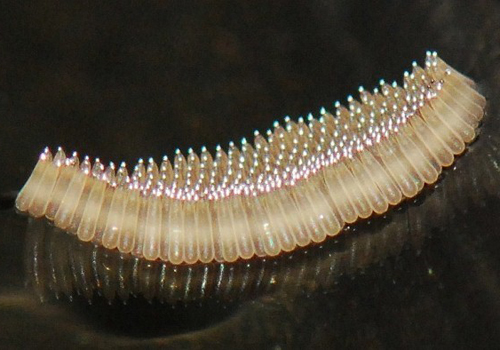
Ades Mosquitoes
They are active day biters and humans are their preferred hosts.
Lay eggs singly on or near the surface of temporary water sources (e.g., used tires, flower pots, pools, roof tanks).
Transmit diseases : Zika, Chikungunya, Yellow Fever, Dengue.
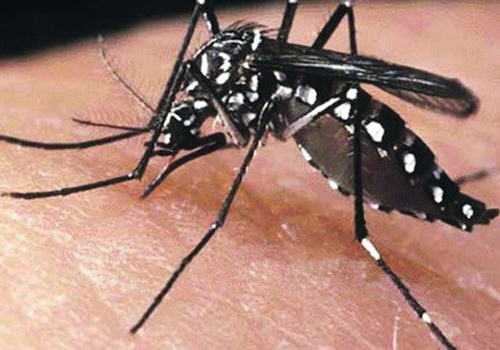
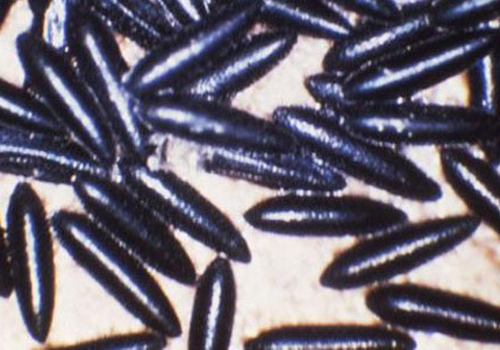
Anopheles Mosquitoes
Bite indoors and outdoors between dusk and dawn and prefer human and mammal hosts.
Lay eggs with floats on the surface of natural, vegetated water bodies (e.g., ponds, marshes, swamps).
Transmit diseases: Malaria
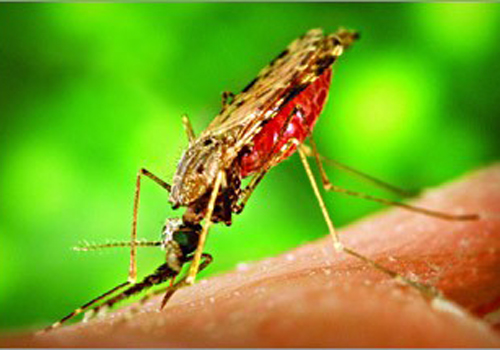
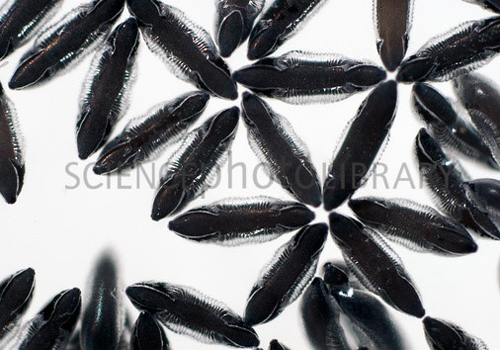
Life Cycle
The length of the mosquito life cycle varies between species and is dependent upon environmental conditions such as temperature and moisture. However, the life cycle of all mosquitoes is comprised of the egg, larvae, pupae, and adult stages.
Male mosquitoes feed on plant nectar alone, while females extract the blood of hosts in order to develop and nourish eggs. Most mosquitoes lay their eggs directly into water. Others lay their eggs near bodies of water but not within them.
Eggs will hatch into larvae within 24 to 48 hours. Larvae soon grow to become approximately 5 mm in length. Most larvae breathe through air tubes. Larger larvae can be seen floating just above the surface of infested waters. Larvae and pupae usually cannot survive without water. If a water source evaporates before the larvae and pupae within it transform into adult mosquitoes, those young often will die.
Within seven to ten days, larvae enter the pupal stage. Pupae are also visible upon the surface of the breeding site. After a mosquito is fully developed, it will emerge as an adult from its pupal case. At this time, the new adult stands upon the water and dries its wings to prepare for flight. Adult female mosquitoes will then seek an animal on which to feed. Females are capable of flying for miles if necessary and can lay over 100 eggs at a time.
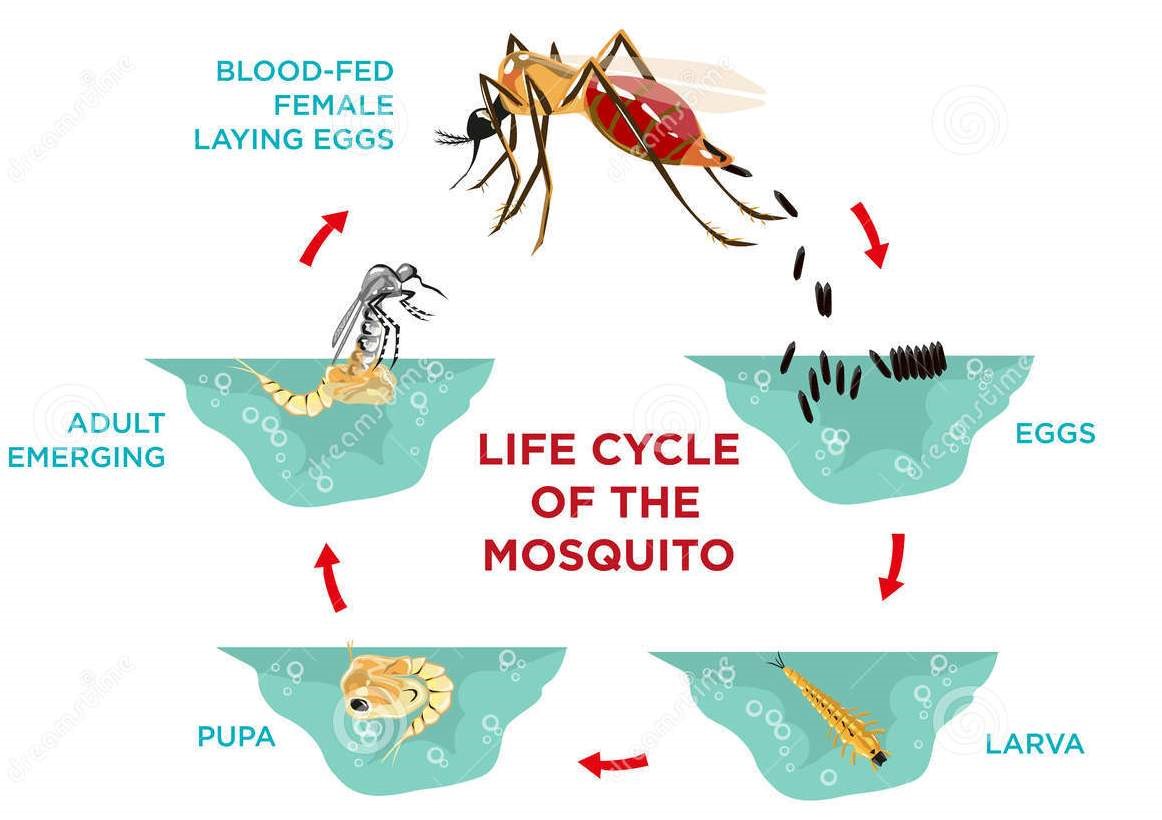
Mosquitoes in the Home
When mosquitoes find their way inside your home through an open door or window, they usually rest in dark, hidden areas, but will come out at night in search of a blood meal. Homeowners sometimes find mosquitoes under sinks or in closets and laundry rooms.
Mosquitoes in the yard
Mosquitoes breed in standing water, so properties near ponds, marshes, and depressions that collect rainwater are at risk. Some mosquito species are active at different times of the day, but most emerge just before dusk and are active at night.
Signs of a mosquito infestation
Signs of mosquito activity include the buzzing of the females and their potential bites. People have differing reactions to bites, ranging from mild irritation to intense inflammation and swelling. The presence of standing water can also provide the optimal environment for mosquito reproduction. Nymphs are found in standing water areas such as water bowls for pets, potted plants, bird feeders, and stagnant ponds.
Problems With Mosquitoes?
You step outside and you’re under attack. That’s frustrating enough. But mosquitoes can also carry disease. That’s why you should get professional help to stop them.
Don’t wait. Get our mosquito service and we will get to work putting your mosquito concerns behind you.
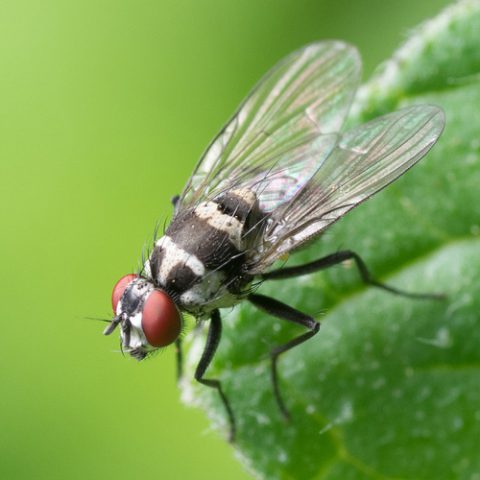

Flies
FLIES

Family: Diptera
Appearance:
There are more than 16,000 species of flies in North America. But they all belong to the order Diptera, meaning two wings. Because they only have two wings, flies land often and therefore can deposit thousands of bacteria each time they land.
Common Fly Species:
- House Fly
- Bluebottle Fly
- Sand Fly
- Fruit Fly
- Drain Fly
- Flesh Fly
- Horse Fly
House Fly (Musca domestica)

House flies are major carriers of disease and can infest all types of premises. They are attracted to all types of food, including human food, pet food, animal feed, food waste and even faeces. Seeing adult flies is usually the most common sign of activity and a potential problem. Larvae may also be seen as they crawl out of breeding material to pupate.
Key Facts
- Adult is 5–8mm in length.
- Grey thorax with 4 narrow stripes.
- Buff or yellow abdomen.
- Covered with small hairs that serve as taste organs.
- Complex compound eyes – with thousands of lenses allows them a wide field of vision.
- 4th wing vein bent and wing tips slightly pointed.
- Larva is white and tapers to a point at the head end. There are 2 spiracle “spots” at the hind end, is legless and 12 mm in length when mature.
Life cycle
House flies are able to quickly mature from an egg to an adult. They breed in moist decaying vegetable matter eg. in uncovered dustbin or pet food.
- Eggs are laid in batches of 120 to 150 and can hatch in 8 – 72 hours.
- The larvae of House Flies can take 3 – 60 days to mature.
- Pupae matures in 3 – 28 days.
Once indoors, house flies can be found resting on walls, floors or ceilings. Outdoors they can be seen on plants, the ground, fences, compost heaps and rubbish bins.
At night them they prefer to rest near food sources approx. 5 to 15 feet off the ground.
Bluebottle Fly (Calliphora vomitoria)

Bluebottle flies (also known as Blow fly) can often be seen hovering around dustbins. These scavengers are attracted to pet faeces and dead animals and as such are known carriers of disease.
Their name originates from their iridescent colours that are similar to coloured bottles.
Key Facts
- Adult is 1/4″ – 1/2″ in length.
- Metallic blue colour.
- Larva — Similar to the house fly larva in all respects except size. 3/4″ when mature. They take 7 – 12 days to mature.
Life cycle
- Eggs hatch 0 – 18 hrs (partial development may occur within the female).
- Breeds in mostly meat derived substances, sometimes cheese.
- Common pest of dead rodents/birds etc.
Sand Fly (Phlebotominae)

Adult sand flies can be seen from April to September. They live on sandy riverbanks with an open habitat free of shading trees.
Females prefer to lay their eggs in damp soil or in the water.
Key Facts
- Adult — 10–11mm long.
- Body has a pale grey colour.
- Eyes are bronze–brown.
Life cycle
- The larvae can take up to two years to develop and live in loose sand.
- In the pupal stage the larvae curls into a circle or “u” shape lasting one or two weeks.
Fruit Fly (Drosophila spp)

Fruit flies are commonly found infesting fruit or hovering around fermenting residues found in pubs, fruit orchards & vegetables plots and breweries.
Key Facts
- 3mm in length.
- Yellow–brown or mottled in colour.
- Bright red eyes.
- Abdomen hangs down in flight, which is slow.
- Tend to hover.
Life cycle
- They can breed in rotten fruit, unclean drains and even cleaning utensils.
- Develops to adult in 7–30 days.
- Adult lives 2–9 weeks.
- In ideal temperature conditions, fruit flies can complete their development in as little as 1 week.
Drain Fly (Psychodidae)

Drain flies are often associated with sewage beds, where larvae feed on sludge–like organic matter. They are also known by a variety of names; drain fly, sewage fly and moth fly are a few examples.
Key Facts
- 2mm in length.
- Tan coloured body appears as grey.
- Wings densely covered in hair and held tent–like over the body when at rest.
Life cycle
- Eggs hatch 1–6 days.
- Larvae 10–50 days to mature.
- Pupae 1–3 days to mature.
Flesh Fly (Family – Sarcophagidae)

Appearance
- 6-14mm long.
- Thorax is light grey and has 3 dark longitudinal stripes.
- Abdomen is also light grey, spotted with dark patches to give a checker board appearance.
Life cycle
- Life cycle require for 2-4 weeks.
- The female deposits live larvae on a suitable feeding medium (this can range from spoilt meat or fish, or animal excrement, or in decaying food waste found in garbage bins).
Habits
- They are attracted to decaying wastes, excrement and human foods – making a threat to human health.
Horse Fly (Family – Tabanidae)

Horse flies are a particular pest to livestock. Relentless biting attacks by females can result in reduced weight gain in some animals.
Male horse flies are mainly pollen and nectar feeders and are most active during daylight hours.
Horse fly bites can be very painful for humans too.They have mouth parts that work like miniature knives, which they use to slash open the skin with a scissor–like motion.
Key Facts
- Adults can be up to 25 mm long.
- Black to dark brown in colour with green or black eyes.
- The males have contiguous eyes, which easily differentiates them from females where the eyes are widely separated.
Life cycle
- Mating is initiated in the air and completed on the ground where the female then deposits an egg mass sometimes with a shiny or chalky secretion, which aids in water protection.
- Eggs are laid in masses ranging from 100 to 1000 eggs on a vertical surface overhanging water or wet ground favourable to larvae development. The eggs hatch in 5–7 days.
- They overwinter in the larval stage and pupate during the spring and early summer.
- Adult life cycle is 30 to 60 days.
Fly Infestation
Noticing a few noisy flies in your house or your business, may not necessarily mean there is an infestation. However, it should act as a warning sign to take some safety measures.
Common Signs
- Small dark clusters of spots (the size of a pinhead) – look at ceilings and other overhead structures and wall surfaces. Check areas that are difficult to clean thoroughly such as drainage channels and drains where waste may be accumulating. Gully traps and areas around sinks and below damaged floor tiling should also be monitored.
- Regular sighting of flies – large number of flies buzzing around garbage dump areas and the base of wheelie bins or other waste containers may indicate a more serious problem. Check anywhere that water pools including in guttering, tyres or old machinery. Waterlogged pot plants may also attract flies.
- Maggots – these are flies in their larval stage and could indicate a potential breeding site on your property. You may discover maggots in waste areas and deteriorating food.
How Serious Are Flies?
Because people correctly associate flies with filth, these pests disgust and annoy residents in homes. The insects can also transfer disease organisms when they touch food and kitchen surfaces. In addition, certain fly species can inflict painful bites on humans and animals.
Disease
Millions of microorganisms may flourish in a single fly’s gut, while a half-billion more swarm over its body and legs. Flies spread diseases readily because they move quickly from rotting, disease-laden garbage to exposed human foods and utensils. Every time a fly lands, it sloughs off thousands of microbes which can cause serious illnesses like:
- Bloodstream infections
- Diarrhea
- Food poisoning
- Meningitis
More than 100 pathogens are associated with the house fly, including Salmonella, Staphylococcus, E. coli, and Shigella. These pathogens can cause disease in humans and animals. Some of the diseases include:
- Cholera
- Bacillary dysentery
- Hepatitis
- Typhoid fever
Fly Prevention
The best way to repel flies is through simple, preventive measures. In order to best repel flies, limit access to your home as much as possible, keeping doors and windows closed. You may also choose to screen windows, doors, and vents. Keep garbage cans clean and securely closed. Keeping surfaces clean will make your home less appealing to flies. For best results, contact a pest control professional to discuss extermination options.
How Do I Get Rid of Flies?
The Better Care pest control technician is trained to help manage flies and similar pests. Since every building or home is different, your Better Care technician will design a unique program for your situation.
The Better Care technician can provide the right solution to keep flies in their place…out of your home, or business.
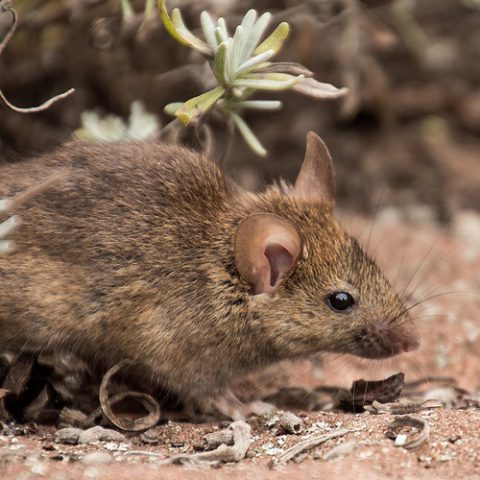
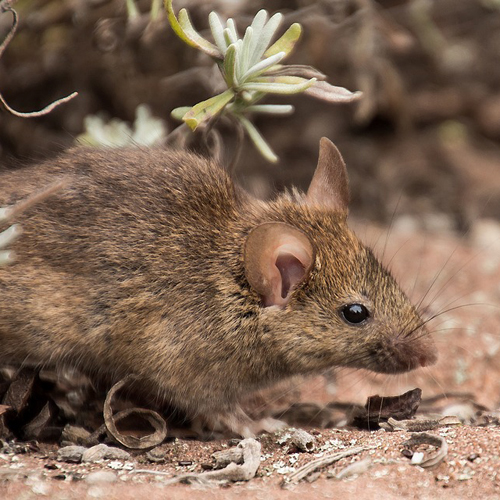
Rodents
RODENTS

Order: Rodentia
Appearance:
Rodents are warm-blooded mammals that, like humans, can be found throughout the world. They have oversized front teeth for gnawing and check teeth, which are adapted for chewing. Rodents chew on a variety of items available to them and cause great damage in and around homes.
Common Types of Rodents:
- Norway Rat
- House mouse
- Roof Rat

Norway Rat – Brown Rat (Rattus norvegicus)

Norway Rat (Brown rat) usually prefer ground living and burrowing, but sometimes they can be known to climb.
Appearance
- The Norway rate is up to 40 cm in length, with a tail shorter than the head and body.
- It grows up to between 350–500g in weight.
- It has a blunt nose, small ears and a thicker body when compared to the Black Rat (Rattus rattus).
Habits
- Preferred food is cereals, although they are omnivorous.
- They will eat around 30g of food a day and drink 60ml.
Life cycle
- Rats have 7–8 young per litter, and between 3–6 litters a year.
- The gestation period is about 3 weeks.
- It only takes 10–12 weeks from birth to reach sexual maturity.
House Mouse (Mus musculus)

Where is house mouse found?
Capable of surviving nearly any environment – small size, high adaptability + needs extremely small amount of food and space.
Appearance
- 7 – 9.5cm in length, with a tail around the same length
- 12 – 30g in weight.
- Their relatively small feet & head and large eyes & ears distinguish them from a young brown rat (Rattus norvegicus)
Habits
- Usually ground living and burrowing, but often climbs.
- Preferred food is cereals.
- Will eat around 3g of food a day and can survive without any additional water. They will drink up to 3ml a day if their diet is particularly dry.
Life cycle
- 4 – 16 young per litter; 7 – 8 litters a year.
- Gestation period of about 3 weeks.
- 8 – 12 weeks from birth to sexual maturity
Roof Rat – Black Rat (Rattus rattus)

Black rats can be found in coastal towns and in many urban environments.
Apperance
- The black rat is between 16–24cm in length, with a tail longer than the head and body.
- It grows to between 150–200g in weight.
- They have a pointed nose, large ears and a slender body.
Habits
- They are incredibly agile and very good climbers.
- Their preferred food is moist fruits. Black Rats will eat around 15g of food a day and drink 15ml.
Life cycle
- Black rats produce 5–10 young per litter, and have between 3–6 litters a year.
- The gestation period is about 3 weeks.
- It only takes between 12–16 weeks from birth for them to reach sexual maturity.
Signs of Infestation
- Rat Droppings – Norway Rat droppings are dark brown in a tapered, spindle shape – like a grain of rice.
- Bite Marks – Rats tend to gnaw on wood and plastic to keep their teeth trimmed.
- Rub Marks – Grease and dirt on their bodies leaves smudges on surfaces.
- Scratching Noises – Black rats are agile climbers and often found in lofts to you might hear scratching noises at night.
- Rat Holes – Norway rats are well known for digging extensive burrow systems for shelter, food storage and nesting.
- Rat Nests – Rats will shred available materials such as loft insulation, cardboard and other soft items to make nests.
- Footprints – Rats leave foot and tail marks in dusty, less-used areas of buildings.
How can I help prevent a rodent infestation?
We recommend the following tips for rodent control in and around the home:
- Keep foodstuffs in metal or glass containers with tight fitting lids.
- Tidy inside the house and around the garden — less clutter means less places to hide.
- Place outdoor rubbish bags in metal bins with securely fitted lids to stop them feeding from contents.
- Clean up pet food and bird seed debris, and store pet food in robust containers with fitted lids – preferably above ground level.
- Keep gardens free from debris. If you have compost heap don’t include organic food waste, as this will attract them.
How Do You Get Rid of Rodents?
If you do see any of the signs mentioned above you need to act quickly to ensure any potential rat infestation is controlled quickly before it can spread, So call us for a free quote and speak to our technician who will be able help you.
We recommend acting quickly as rats are well known to spread diseases, damage property, contaminate food stuffs and also introduce parasites like fleas, lice and ticks into your property.


Cockroaches
COCKROACHES

Order: Blattodea
Appearance:
Cockroaches can measure over 50 mm (2 in) length, with tropical species tending to be larger than those found in other climates. Cockroaches have six legs, two antennae and some have wings. However, most winged cockroaches are not particularly adept at flying.
Common Types of Cockroach:
- German cockroach
- American cockroach
- Brown Banded Cockroach
German Cockroach (Blatella germanica)

Apperance
- Adult is 10 – 15 mm in length.
- Pronotum (head shield) has 2 dark longitude stripes.
- Male is light yellowish brown in colour with longer tongue shaped body.
- Female is darker in colour with plump abdomen.
Habits
- Major pest in restaurants, hotels and apartments.
- Prefers dark and secluded areas to harbourage such as under the cupboard and behind a refrigerator.
Life cycle
- Female produces 4 – 9 oothecae (egg case), each oothecae contain 37 – 44 eggs.
- Nymphs take 30 – 60 days to mature into adults.
American Cockroach (Periplaneta americana)

Appearance
- Adult is 35 – 40 mm in length, one of the largest pest cockroaches.
- Shining red to chocolate brown in colour.
- Life cycle and habits of the American Cockroach
Habits
- Prefers warm and humid environment such as drains and sewers.
Life cycle
- Female produces 10 – 90 oothecae (egg case), each oothecae contain 14 – 28 eggs.
- Nymphs take 150 days to develop into adults.
Brown Banded Cockroach (Supella longipalpa)

Appearance
- Adult is 10–14 mm in length, one of the smallest pest cockroaches.
- Yellow-brown stripes across the abdomen.
Habits
- Prefers warm and humid environment such as drains and sewers.
Life cycle
- Female produces up to 13 oothecae (egg case), each oothecae contain 16 eggs.
- Nymphs take 55 days to develop into adults.
- In ideal temperature conditions (30°c), adult lives 90 – 115 days.
Signs of Cockroach Infestation
Cockroaches are most active during the night, preferring to stay hidden in cracks and crevices during the day. They are attracted to food available in your property and will feed on nearly anything from food crumbs to animal droppings / faeces.
If you suspect a cockroach infestation, it is essential to take immediate action to ensure a fast solution to the problem and to minimise health risks associated with this pest.
Here are some tell-tale signs that indicate cockroach presence in your premises.
- Droppings – black grainy droppings can be found in the cabinets and along the walls or routes that they travelled on.
- Smear marks – where water is abundant, brown and irregular shaped smear marks will appear on horizontal surfaces and wall floor junctions.
- Moulted skin – evident of brownish skins can be found close to where they are breeding as immature cockroaches shed skins about 5-8 times when they mature to adult.
- Egg cases – appear as small dark brown oval-shaped casings.
- Damage – look for signs of damage on food packaging and organic goods including leather and books.
- Unpleasant odour – a distinct musty smell when cockroaches present in large numbers.
- Live cockroaches – usually found around bathrooms and kitchens.
How to Prevent Cockroaches
Your property could be an ideal breeding ground for certain species of cockroaches. It can enter your property through multiple entry points, such as cracks, crevices, vents, sewers and pipe drains.
The most effective way to keep cockroaches away is to deny them easy access to food, water and shelter, which are the main factors that attract them into your home or business.
Here are practical steps you can take to reduce the risk of an infestation.
- Eliminate food sources – store dry foods in tightly sealed containers or in sealed plastic bags and do not leave food sitting out in open space.
- Clear all waste food and spillage – clean up food debris from food preparation areas, under sinks and appliances. Empty the rubbish on a daily basis and keep all waste in covered bins.
- De-clutter – remove old stacks of newspapers and magazines, unused cardboard boxes and all other forms of clutter from the floor or bottom of cupboards that may provide a hiding place for cockroaches.
- Seal entry points – seal areas such as gaps around door, pipes and cracks to reduce cockroaches hiding place and access into your property.
How Do You Get Rid of Cockroaches?
If you are worried about cockroaches, Better Care can offer professional cockroach control to protect your home and business premises from this unwanted neighbor.
For a professional solution to your cockroach problem, call Better Care Pest Control today for your home or for your business premises.
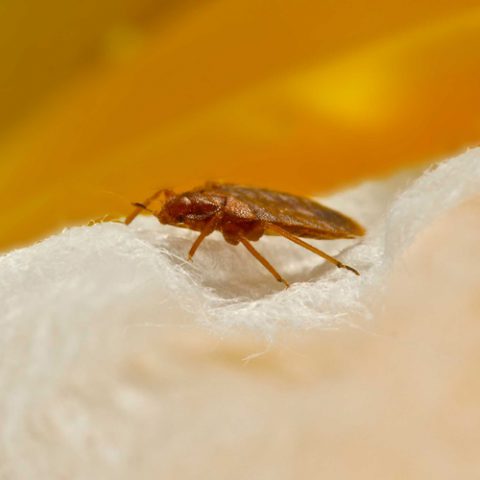

Bed Bugs
BED BUGS

Family: Cimex lectularius
Appearance:
- Bed bugs are around 5 to 6mm long before a blood meal extending to about 7mm when fully engorged.
- Oval and flattened from back to underside with thick, well-developed legs. Bed bugs do not have wings.
- Their mouthparts are modified for piercing and sucking.
- Adult bed bugs are rusty red-brown in colour.
- Eggs are whitish cream, getting darker as they hatch to larvae.
- Their shed skins are lighter brown and look like flaky exoskeletons.
Life cycle
- Bed bugs lay 200 – 500 eggs over a 2 month period in batches of 10 to 50.
- The adult female must have a blood meal before egg-laying.
- The eggs are usually laid in crack and crevices and can be attached to items of furniture or fittings in clusters by a transparent substance.
- There are 7 stages to the life cycle from egg to fully grown adult which can be from 45 days but may be up to a year.
- The typical lifespan of a bed bug is about 6 months over a year depending on favourable conditions.
- They can survive for weeks to months without feeding.
Habits
- Bedbugs feed on human blood and are attracted to body heat and CO2 from sleeping humans.
- They inject an anaesthetic when they pierce the skin, so the bite can go unnoticed at first.
- They are found in cracks and crevices, headboards, behind peeling wallpaper, broken plaster, light switches, under carpets and skirting boards etc. so they are near to people for feeding.
- Bed bugs usually visit their host for a blood feed just before dawn. When alarmed they move quickly and emit an odour.
Signs of Bed Bugs
Bed bugs hide in tiny cracks and crevices and usually visit their host for a feed briefly in the few hours just before dawn. To an expert pest controller, signs of bed bugs are easy to spot. To an expert pest controller, signs of bed bugs are easy to spot but can be a little harder for the untrained and inexperienced eye.
Here are a few of the common signs that there may bed bugs in one of your rooms.
Bed Bug Infestation Signs
- Dark/black stains – on the mattress and surrounding area from bed bug excreta.
- Sweet scent – An unpleasant, sweet, sickly scent.
- Small dark spots – Small dark blood spots on bedding known as ‘faecal pellets’.
- Live insects – despite being small (adult are only 4-5mm long) it’s possible to spot live bed bugs and shed skins.
- Blood spots – on the sheets or mattress.
Where Will I Find Bed Bugs?
- Bed frames and headboard crevices
- Mattress seams
- Carpets and underlay
- Skirting boards
- Between timber floorboards
- In cracked or broken plaster, behind peeling wallpaper
- Inside electrical sockets and fittings
- Drawers and cupboards
- Wardrobes
- Bedside cabinets
- Bed Bug Bites
How To Get Rid of Bed Bugs?
Bed bugs hiding in the tiniest creak and crevice makes it a challenge to spot these flat and brown crawling bloodsuckers. Sometimes, bed bugs have been mistaken as cockroach nymphs or even beetles.
In this case, you would need to be sure if your place has been infested with bed bugs to quickly take action and prevent an infestation that can get out of control in a matter of just 10 weeks!
The situation can be more challenging with bed bug surviving for up to a year without a meal. An infestation can happen quickly as an adult female bed bug lays an average of 5 eggs per day which is about 200 to 500 eggs in her lifetime.
Knowing the signs of bed bugs is critical to adequately and accurately identify the pest. As they usually come out at night, typically an hour before dawn, it is quite not possible to see a bed bug coming out to bite you when you are already sleeping.
Did you know? Bed bugs don’t just live and hide in bedrooms. They can be found anywhere in the house!
Contact Better Care today to get rid of your bed bug problem and eliminate any stress or pest concerns you have in your home or business.
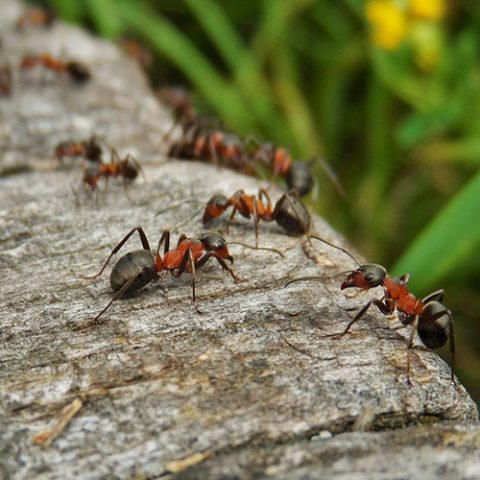

Ants
ANTS

Family: Formicidae
Appearance:
Adult ants species come in a variety of shapes and sizes but each will be one of three different colony castes; queens, workers or males. Queens are fertile females that lay all the eggs in a colony. Workers are wingless females that gather food, feed larvae, maintain the nest, defend the colony, and do not reproduce. Male ants are winged and their only job is to mate with the queens during the swarming process.
Common Types of Ants
- Black House Ant
- Fire Ant
- Ghost Ant
- Odorous House Ant
- Pharaoh’s Ant
- Carpenter Ant
Black House Ant (Ochetellus)

Appearance
- Shiny and black.
- 5 – 3mm long.
Habits
- These ants are regarded as a nuisance and scavenge in kitchens, garbage and also dog excrement, therefore potentially spreading diseases such as salmonella.
- The most effective control measure is to find the colony and treat it.
Life cycle
- Larva hatches out of the egg as a white grub which is narrower towards the head. They are fed by the adults.
- The larva pupates and appears creamy-white, looking similar to an adult. Sometimes they have a protective silk cocoon around them.
- The adult emerges with the three defined body sections: head, thorax and abdomen.
- The length of time between the egg stage and ants emerging as adults can take 6 weeks or more; it depends on a variety of factors such as the species of ant, the temperature and the availability of food.
- Fertilised eggs become female, unfertilised become males.
Fire Ant (Solenopsis spp)

Appearance
- Queens 5/8″ long.
- Workers 1/8″-1/4″ long.
- Coppery–brown on the head and body, with a darker abdomen.
- Solenopsis has a very distinctive two–segment antennal club, which is most visible in the front view of the female reproductive ant.
Habits
- Foraging workers diet consists of dead animals, including insects, earthworms, and vertebrates. Workers also collect honeydew and forage for sweet food, proteins, and fats.
- Nest locations can be a mound of up to 40 cm or next to objects found on the ground, e.g. logs.
- If aggravated, these react aggressively and can inflict a painful sting, resulting in a pustule some 48 hours later.
- These ants are a major agricultural and urban pest, destroying crops and invading residential areas both outdoors and indoors.
Life cycle
- After swarming from the nest and mating, the queen searches for a suitable spot to lay her eggs. Once found, she can lay up to 125 eggs in late Spring.
- Larvae hatch within 8 to 10 days, and the pupal stage lasts for 9 to 16 days.
- Larvae feed on secretions from the queen’s salivary glands and broken down wing muscles until the first worker ants emerge. After this first batch of larvae moult into workers the queen’s role returns to egg laying – she can lay up to 1500 per day. Worker ants continue with larval care, nest building and food foraging.
- Fertile males are produced later in the season.
Ghost Ant (Tapinoma melanocephalum)

Appearance
- Pale/Translucent legs and abdomen.
- 16mm long.
Life cycle
- Continuous breeding colonies.
Habits
- Feeding – indoors: sweet substances and grease; outdoors: insects that produce honeydew.
- Nesting – indoors: small spaces, wall voids; outdoors: in flowerpots, under objects on the ground, under loose bark.
- Locations – attracted to high moisture areas, can be found in kitchen and bathroom cabinets.
- Colonies can occupy several different nesting sites.
Odorous House Ant (Tapinoma sessile)

Appearance
- Brown or black.
- 1/16 to 1/8 inch long.
- Antennae have 12 segments and are not terminated with a club.
- 6 legs.
Life cycle
- Time to adult phase of development is 34-38 days.
- Typically live for several years.
Habits
- Feeding – eat most household foods, especially sugary food, eg sweets and fruits such as melon. Also eat pet food.
- Locations – attracted to moisture. In hot, dry environments nests can be found in house plants and even lids of toilets.
- Odour – produce a coconut smell when crushed.
- Colonies – range in size from 100-10,000.
Pharaoh’s Ant (Monomorium pharaonis)

Appearance
- Workers 1.5-2mm long, yellow-brown with brown abdomen.
- Males 3mm long, black, winged.
- Queens 3.5-6mm long, dark red in colour with wings.
- Black eyes, 2 small segments at the pedicel.
Life cycle
- Multi-queen colonies.
- Swarming can take place at any time of the year.
- Winged adults seldom fly so rarely seen. Wings are soon lost after mating.
Habits
- Well–defined trails are laid which are often associated with heating systems. Feeds indoors on high protein foods — meat, fats, blood, dead insects, etc.
- Swarming characteristics — new colonies are often formed through nests that have been disturbed e.g., as a result of insecticide spray treatments.
- Each queen produces up to 3,500 eggs in its lifetime.
- Nest locations — deep seated in cavities in heated buildings. Often found in hospitals. Associated with humid conditions. Colonies can range from a few dozen to 300,000 individuals.
Carpenter Ant (Camponotus pennsylvanicus)

Appearance
- Workers: 1/4″ long.
- Queen: 1/2″ long.
- Blackish color most common but can also be black and red.
- 6 legs.
Life cycle
- It takes 3 – 6years to establish a large and stable colony.
- The life cycle of a carpenter ant is estimated to be 6 – 12 weeks from egg to adult.
Habits
- Locations – both moist and dry wood, but prefer moist, e.g. wood dampened by water leaks.
- Internally – excavate galleries in wood with a smooth appearance.
- Externally – sometimes hollow out sections of trees.
- Visibility – hunt for food mainly at night but also during the day in early spring / summer. Signs include sawdust, wet wood, or unusual noises coming from the walls.
- Feeding – primary food is honeydew, also eat plant secretions, fruit juices and insect remains. They do not eat wood. In homes they are attracted to sweet substances, fats, grease and meats.
- Contact – rarely come into contact with people, but if they do will try to escape. They cannot sting.
Ant Infestation Signs
- Live ants – If you’re seeing large numbers of live ants then you may well have a problem. If you find them in your kitchen or in areas where you prepare food, then you need to do something about it fast.
- Ant pathways – ant trails in and out of your home or premises are another sign. Some ant species will lay down a pheromone trail to a food source. This trail leads other ants from the colony to the food source.
- Ant nest – A nest site can look like a small pile of soil or dirt. Some species of ant like to make their home in walls or other quiet, dark places, which are more difficult to spot.
How to Prevent Ants
If you are worried that you might be at risk from an ant infestation, you can put in place some proactive ant deterrent measures. The list below will help you minimise the risk of ant infestation in your home or business premises.
Most ants come into your kitchen to look for food. They are attracted to anything that is sweet and sticky, which is why you will normally find ants in kitchen cupboards or areas where food is kept. To keep ants away, you must remember to:
- Clear up – food and liquid spillages immediately.
- Sweep up – any food crumbs from under your kitchen appliances and units.
- Store your food – in airtight containers wherever possible.
- If you have a pet – clear away any food that isn’t eaten straight away.
- Exclusion – the entry points for ants by sealing all cracks and crevices around your doors and window frames.
- In the garden – keep your compost enclosed and make sure all rubbish bins have tightly sealed lids.
- Cover all food – you don’t know where ants have been walking before they march across your food.
Don’t let ants take over your kitchen! Contact Better Care today to get rid of your ant problem and eliminate any stress or pest concerns you have in your home or business.
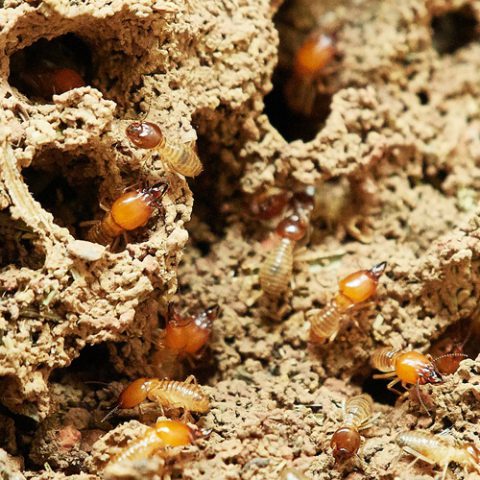

Termite
TERMITES

Latin Name: Isoptera
Appearance:
Termites all belong to the phylum Arthropoda, the class Insecta, and the order Isoptera. There are over 2,000 different species of termites with over 40 species. Although they have distinct characteristics, most look similar. They typically measure between 1/4 and 1/2 of an inch long and have soft bodies with straight antennae. The queens and kings are larger, capable of reaching over one inch long. Colors range from white to light brown where worker termites often appear lighter, while swarming termites darker. Flying termites, also called reproductive, have two pairs of prominent wings.
Termites (also known as ‘white ants’) thrive and grow very well in tropical climate with high humidity and rainfall. There are two main species of termites capable of causing extensive damage, leading to costly repairs and structural failure.
Types of Termite
- Subterranean Termite
- Drywood Termite
- Dampwood Termite

Subterranean Termite

Drywood Termite

Dampwood Termite
Termites come from the following:
- Underground soil
- Infested wooden furniture
- Via mud tubes
- Flying alates
Termite Society
The basic castes in a colony are queens, kings, workers, soldiers and alates.
Termite Queen & King
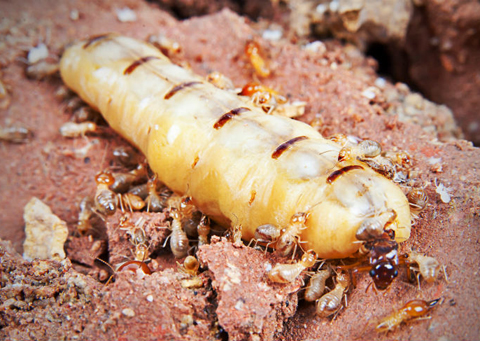
Giving life to the colony
The function of the Queen and King in the termite colony is to reproduce. Starting out life as an Alate, they leave their parents’ colony, drop to the ground and shed their wings to seek out an environment to nest. They care for their young until they are able to take over the duties of the colony.
Termite Workers
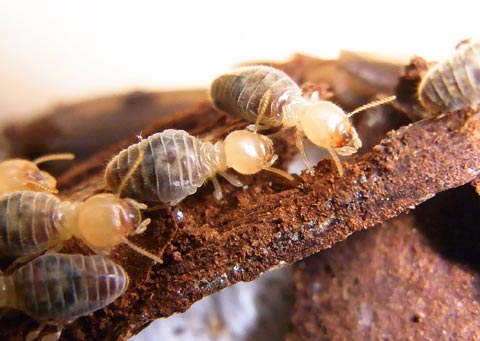
The ‘doers’
The workers make up the largest number within a colony. They do all of the work (except defend and reproduce): feeding, grooming, excavating the nest and making tunnels. In doing their jobs, they cause the destruction that effects so many homes.
Termite Soldiers
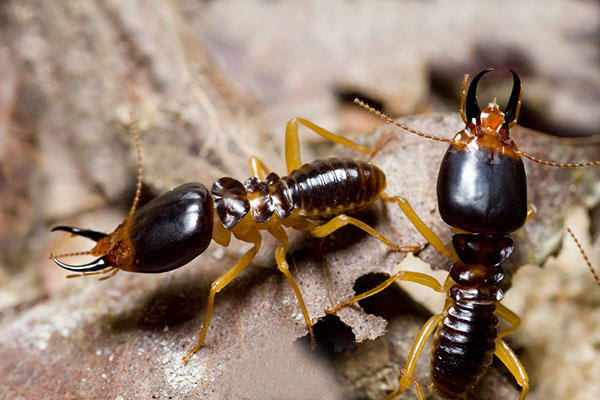
The colony’s defence
Soldiers defend the colony against attack by predatory enemies such as ants, and are equipped with large jaws, sticky fluids or chemical spray to do so.
Alates

The future Queens & Kings
Alates are the winged reproductives that swarm out from the nest and establish new colonies. Male and females pair off and look for a suitable environment to mate. They are often confused with ant swarmers.
Behavior, Diet & Habits
Where do they live?
Commonly, termites live in wooden structures, decayed trees, fallen timber, and soil. Habitats vary among species as some termites require different amounts of moisture. The pests are found in greater numbers in tropical regions where living conditions for termites is optimal.
Subterranean termites are the most abundant variety and can be found throughout the United States. Both dampwood and drywood species are generally more localized in the Southern states.
Subterranean termite homes are usually formed in soil. Within these mounds, termites build elaborate tunnel systems and mud tunnels through which they access above-ground food sources.
Drywood termites live within the wood they consume and oftentimes infest walls and furniture.
When a colony has matured, winged, swarming termites can be seen around windows and doors. Winged termites are highly attracted to sources of light and are most active in springtime. After mating, these termites locate a new breeding site and create another colony, spreading infestations throughout multiple locations in the case of drywood termites.
What Do They Eat?
Termites are detritivores, or detritus feeders. They feed on dead plants and trees. Termites get nutrients from cellulose, an organic fiber found in wood and plant matter. Wood makes up the majority of the pests’ diet, although termites also eat other materials such as paper, plastic, and drywall. Most species prefer dead wood, but some termites feed on living trees.
Each type of termite has its own dietary preferences.
- Subterranean termites prefer softwoods, but may invade most species of wood.
- Dampwood termites generally stay close to the ground, but will choose moist, decaying wood anywhere it is found.
- Drywood termites are often found in attics and require little moisture in the wood they eat.
A termite’s mouth is capable of tearing pieces of woody material. This ability is what causes concern in human dwellings: while termite workers only measure approximately 1 cm to a few millimeters in length, their feeding habits are capable of causing costly damage to property. House foundations, furniture, shelves and even books are all possible feeding sites for termites.
Signs of Termites
Termite infestation is usually not apparent until severe damages have incurred. They live in dark, humid and protected environment, which make them so hard to find – until it’s too late.
As termites devour their way through wood from the inside, it can be rather challenging to detect a termite infestation but there are some tell-tale signs that indicate their presence.
Here are a few common signs of termites that you might see (or hear) around your home or business premises:
- Mud tubes on wall – Subterranean termites build shelter tubes made of mud, dirt and debris in order to travel to and fro the food source without being seen. These tubes are about the size of a coin and are usually found on exterior and interior walls leading up to the entry points of the building.
- Sightings of termite swarmers (flying termites) or discarded wings – Usually the first sign of infestation noticed by property owners are the presence of swarmers or alates. Another common indication is the remnants of discarded wings on windowsills and floors.
- Papery or hollow sounding timber – Termites usually consume woods from the inside out, leaving a thin veneer of timber or paint. So when you knock or tap on an area that has termite damages, it will sound hollow or feel papery due to parts (or all) of the timber having been eaten away.
- Tight fitting door or hard to open window – As termites devour timber, their excrement or ‘mud’ creates a protective environment that traps heat and moisture. This causes timber to swell, making it harder to open or close the infested windows and doors.
- Tunnels in the wood – Also known as ‘galleries’ which are quite difficult to see from the outside.
- Termite droppings – After consuming wood, dry wood termites often leave behind brown-coloured and grainy faecal mounds. These faecal pellets are usually found beneath the infested wood.
How do I prevent termite infestation?
Since termites are a constant threat to your home, here are some things you can do during the year to help maintain the effectiveness of Better Care’s termite treatment plan. Small steps make a big difference in termite prevention and sustaining an effective termite treatment plan. Start by eliminating moisture conditions and termite food around your home. These simple steps make your home a less attractive target, helping deter termites.
Eliminate Moisture Problems
- Repair leaking faucets, water pipes, and A/C units
- Divert water from foundation
- Keep gutters and downspouts clean
- Remove excessive plant cover and wood mulch
- Get rid of standing water on roof
- Keep all vents clear and open
- Seal entry points around water and utility lines or pipes
Remove Termite Food Sources
- Keep firewood, lumber or paper away from foundation or crawl space
- Get rid of stumps and debris near house
- Place screens on outside vents
- Check decks and wooden fences for damage
- Wood on your home shouldn’t contact the soil
How Serious Are Termites?
A termite infestation and damage can be devastating to your home or property. Termites are often called the “silent destroyer” because they may be secretly hiding and thriving in your home or yard without any immediate signs of damage. All termites consume cellulose-based plant materials. Unfortunately, all homes, regardless of their construction type, can provide cellulose food for termite infestation.
How Do I Get Rid Of Termites?
Based on the layout of your home and the degree of termite infestation, We will create a customized treatment plan tailored for your home. This can include a variety of treatments such as Dusting trearment, Foaming treatment and Baiting treatment dependent on the areas of usage, situations, and species of termite.
Contact Better Care today to get rid of your termite problem and eliminate any stress or pest concerns you have in your home or business.
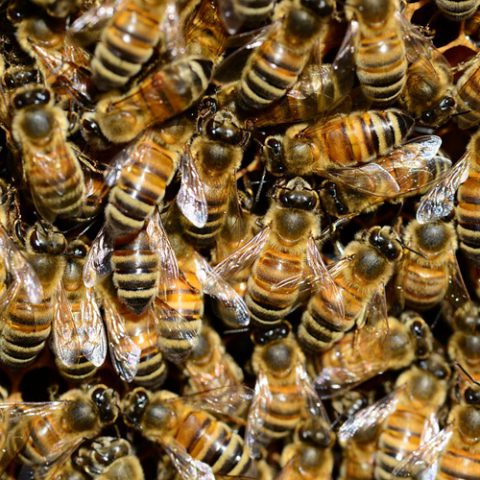

Bees
BEES

Order: Hymenoptera
Appearance:
Bees are winged insects with more than 20,000-recorded species found globally.
- Length: Megachile pluto, the largest of these creatures, is reported to be 3.9 cm long, while Perdita minima, the most diminutive of bees, are shorter than 2 mm long.
- Color: Bees can be black or brown with red, yellow or lustrous blue stripes.
Common Types of Bees
- Honey Bee
- Solitary Bee
- Carpenter Bees
- Bumble Bee
Honey Bee (Apis cerana)

- They live in hollow trees or in chimneys, wall cavities or roof spaces.
- They are similar in size to wasps but are furrier and mostly black in colour.
- Honey bees convert nectar into honey and beeswax.
- A honey bee swarm will arrive in flight and cluster on a tree branch.
- A colony size can often be greater than 30,000 individual honey bees.
- Population under threat from varroa mite.
Solitary Bee (Megachile spp.)

Appearance
Often similar to the honey bee.
Life cycle
- Colony size – small nests which are individually tended by a female.
- Preferred nest sites – often in soil, sometimes in soft cement and mortar between bricks.
- Nest construction – various materials. Usually a new nest each year.
Habits
- Swarming – does not swarm.
- Overwintering – usually in the pupal stage within the nest.
- Food preferences – honey and pollen.
- Rarely stings.
Carpenter Bees (Xylocopa latipes, Xylocopa aestuans.)

Appearance
- 3/4 – 1 inch long.
- Female faces are black, male faces are yellow.
- Bright yellow, orange or white hairs on the thorax.
- No hair on abdomen.
- Females have a stinger, males do not.
Life cycle
- Tunnel into wood to lay eggs.
- Life cycle from egg – larva – pupa – adult takes approximately seven weeks.
- Larva is large and noisy.
- New adults emerge from the nest late August.
Habits
- Sting – Only sting if provoked.
- Visibility – Late-spring to mid-October.
- Nesting – Bare, untreated softwoods are preferred, including redwood, cedar, cypress and pine. Old nests are used year after year.
- Location – Nests can be found in eaves, window trims, facia boards, siding, decks and outdoor furniture.
- Feeding – flowers that contain pollen, eg Bradfords, Daffodils, Pansies. Pollen stored in abandoned tunnels for overwintering.
Bumble Bee (Bombus sp.)

Bumble bees are often confused with honey bees.
Key Facts
- They are larger and furrier than honey bees.
- Dark coloured except for golden stripes across the end of their tails.
- Bumble bees nest in small wall cavities, holes in the ground, under sheds or in undisturbed compost heaps.
Bee Stings
Although known for their role in pollination and producing honey, bees can become a threat to homeowners when they build their hives near or inside homes. Bees are considered less dangerous than other stinging insects like wasps. There are aggressive species such as the Africanized honey bees that will sting humans in large numbers.
Bee stings have the potential for an allergic reaction, resulting in anaphylactic shock. Anaphylactic shock is a serious medical condition that requires immediate medical assistance and can even cause death.
Signs of Bee Hive
- Carpenter bees look just like bumble bees except that their abdomens are shiny and smooth. Carpenter bees are frequently seen buzzing around unpainted buildings and boards. The oval-shaped insects will bore into wood in order to lay their eggs. To identify an infestation, routinely check wooden areas of your home for round, smooth holes.
If left untreated, carpenter bees have the potential to inflict serious damage to your home by drilling too many holes potentially making the building structure unstable. They are solitary bees, so they do not live in colonies and will rarely sting humans. - Honey bees can be in various shades of yellow, black, brown or orange, and their bodies are covered with light-colored hair.
Honey bees will swarm to form new colonies when the colony gets too large for hive space or new queens are produced. Honey bees are not particularly aggressive except when the nest is disturbed. - Bumble bees physically resemble carpenter bees, except that bumble bees have hairy abdomens. Bumble bees do not make tunnels in wood, but rather nest underground or in cavities, such as in abandoned rat burrows.
In general, bumble bees are seldom problematic, except in situations where the nests are established in a location where it is highly likely to conflict with people or pets.
How to Get Rid of Bees
It is important to properly identify the particular species living near your home, as bees are often mistaken for wasps each requiring unique treatment methods.
The only way to rid a home of bees is to remove the hive entirely. For safety and efficiency purposes, contact Better Care Pest Control for help with bee control.
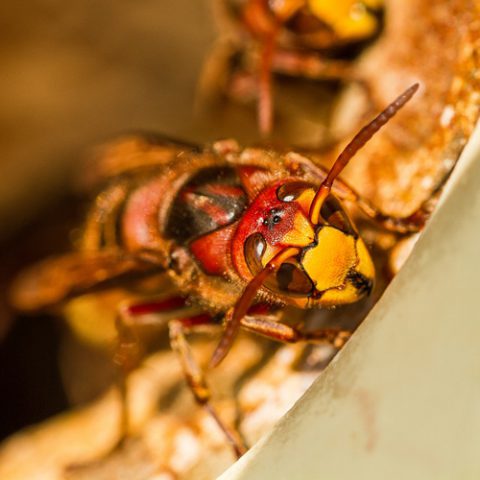
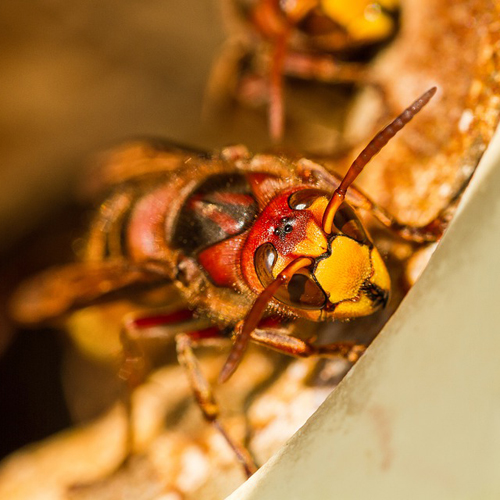
Hornets
HORNETS

Scientific Name: Vespa crabo
Appearance
- Size: The adult European hornets are approximately 1-1.5 inches long. Queens are the largest member of the hornet colony.
- Wings and Legs: Hornets have two pairs of wings and six legs.
- Color: Dolichovespula maculata, the bald faced hornet, resembles a larger version of a common yellow jacket, except they have whitish-colored facial, thoracic, and abdominal markings. European hornets have a reddish-brown head, thorax, first abdominal segment, and legs.
Common Types of Hornets
- European hornets
- Bald faced hornets
Behavior, Diet & Habits
European hornets are not as aggressive as bald faced hornets, but will nevertheless sting if their colony is disturbed. Hornet nests can be found in locations, such as:
- Attics
- Porches
- Inside wall voids
- Tree branches or hollows
- Thick bushes
Life Cycle
Growing Colonies
Colonies usually have an annual life cycle. Colony success depends on the ability of hornet queens to survive the cold weather of winter. Fertile hornet queens begin building new nests in the spring and also start laying eggs. As the eggs hatch and become hornet grubs (larvae), queens works to enlarge the nest. This is done by hunting for insects to feed to larvae.
In time, larvae mature, go through a pupal stage, and develop into the first generation of adults. At this point, queens cease work enlarging the nest to focus on laying eggs. The first and subsequent generations of hornet workers assume the role of nest builders, protectors, and food gatherers for the remaining members of the colony.
How Serious Are Hornets?
When hornets perceive threats near their nests, they become aggressive and can deliver painful stings. Angered hornets can also squirt venom into the eyes of enemies, causing temporary blindness. While their stings typically cause no long-term damage, the pain from stings is intense and people allergic to their venom may have serious medical reactions.
Sting Reactions
When someone is stung multiple times or is highly allergic to the insect’s venom, there can be systemic reactions that may affect the entire body. Typical symptoms and reactions to stings are:
- Intense pain
- Redness
- Swelling around the site of the sting
Signs of Infestation
The most obvious signs of a hornet problem are presence of adults and nests. During the time that nests are being built, it is common to see hornets scraping away a thin layer of wood from a wooden fence, an old log, or the side of an unpainted wooden building.
How to Get Rid of Hornets?
The first step in hornet control is to identify the pest. Once that is determined, your pest control technician will develop a specific treatment plan for your individual needs. While sometimes possible, it usually isn’t wise to attempt any do-it-yourself efforts. Complete control may require more than one treatment visit to ensure all of the pests are eliminated.
Contact Better Care today to get rid of your bee, wasp and hornet problem and eliminate any stress or pest concerns you have in your home or business.
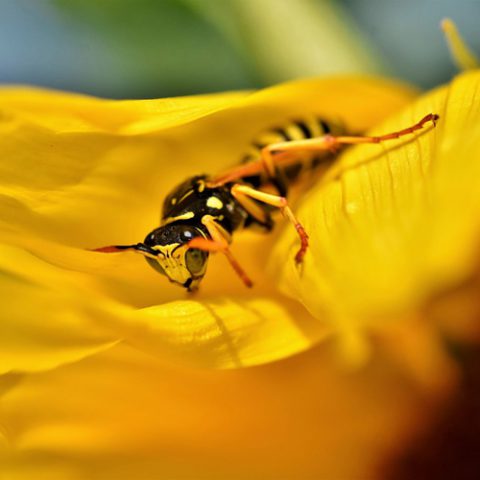

Wasps
WASPS

Order: Hymenoptera
Appearance:
- Varies tremendously depending on species.
- Wings: Most have two pair of wings and a pinched waist.
- Color: They range in colors from black to metallic greens and blues
- Size: vary in size from almost microscopic to several centimeters long.
Wasps Species
- Eastern Cicada Killer Wasp
- European Paper Wasp
- Great Black Wasp
- Ground Wasps
- Mud Dauber Wasps
- Paper Wasps
- Red Wasps
- Sawflies
- Spider Wasp
- Types of Wasps
- Wood Wasps
Behavior, Diet & Habits
Colonies
Wasp species are categorized as social or solitary. As their name implies, social wasps live in colonies, which may number in the thousands. Within these colonies, female workers perform all duties within the nest. Solitary wasps live alone and therefore do not have a colony. They do lay eggs, but their eggs are left alone to hatch.
Some wasps are predatory, while others are parasitic. Predatory wasps kill and consume other insects as well as other animals which they often feed to their larvae.
Parasitic wasps typically lay their eggs in the bodies of living creatures like caterpillars or spiders. The larvae feed on the still-living host. Wasps can assist in the management of other pests, particularly in agriculture as biological control agents. Many wasps also feed on nectar from flowers and therefore function as pollinators.
Some wasps are aggressive species and can sting when threatened. Unlike honey bees, wasps often are capable of stinging multiple times.
Signs of a Wasp Infestation
Signs are dependent on species, but most often the workers and the nest are the most likely signs. Wasps can come inside the home because they are looking for:
- Food source
- Nesting site
- Protected place to overwinter (hibernate)
- Accident or happenstance
How Serious Are Wasps?
Wasps near the home can ruin outdoor activities and make yardwork difficult. While they rarely go out of their way to sting, wasps may become hostile if threatened or disturbed. Their stings are painful but typically nonthreatening to those without allergies to the wasp’s venom.
How To Get Rid of Wasps?
When it comes to getting rid of wasps, we strongly recommend you to contact a pest control professional if you have an infestation. Attempting to remove a wasp hive by yourself can be dangerous, especially if you or someone in your family is allergic to its harmful stings.
YOU HAVE QUESTIONS?
WE HAVE ANSWERS
Don’t hesitate to ask us, just leave an email here. Or call our hotline phone. We’re always glad to hear from you.
Bld 11, Room 11, U Wisara Rd, Taw Win Housing, 41 Extension Quarter, North Dagon, Yangon.



